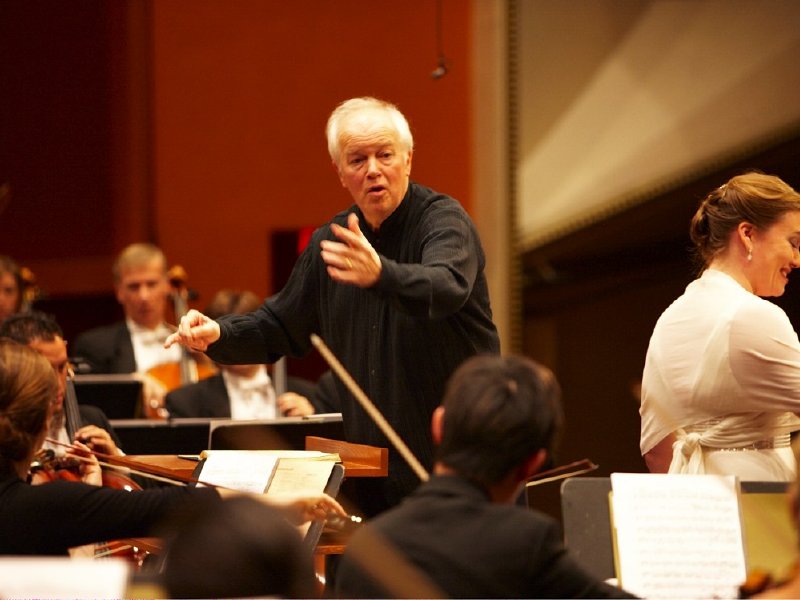The Edo Effect
MSO’s spectacular performance of Nielsen symphony shows impact of maestro Edo de Waart.
This past weekend marked the first time that Carl Nielsen’s Symphony No. 5, Op. 50, was ever performed by the Milwaukee Symphony Orchestra. Completed in 1922, one must wonder what took so long for this glorious composition to make its premiere on our symphony’s stage. Is it too weird? Too hard? Just overlooked? What?
Nielsen’s symphony is unusual in form, to be sure. It has only two movements rather than the conventional architecture of three or four movements, but Nielsen’s construction of two contrasting musical entities works brilliantly to give full shape to the work.
The first movement creates a sonic portrait in which chaos interposes pastoral civility. Icy, shimmering sixteenth notes from the violins quietly opened the movement, and a pair of bassoons warmed the frigid landscape. The horns took the same material and played with haunting melancholy. Soon a solo clarinet line soared above the orchestra and tumbled down to meet the sound of the snare drum, the harbinger of chaos. The juxtaposition of snare drum and clarinet is strongly reminiscent of Nielsen’s Clarinet Concerto, and it is clear from the virtuosic demands of the music that Nielsen must have had exceptional artists at his disposal when he penned both the concerto and this symphony.
The second movement opens with a full-throated scherzo that, although thick with winds and brass, is driven by the fierce passion of the string section. Big blocks of sound, exact intonation, and rhythmic tightness gave the orchestra’s strings a distinguished, burnished tone. As the second movement continued, I sat in awe at the orchestra’s ability to convey the fire of the Nielsen. Each member of the orchestra should be named here for such a compelling performance. The brass created a massive wall of sound with plenty of volume remaining for a gigantic final chord. The woodwind section played with exceptional technical skill, beauty, balance, and intonation. The strings—from driving pizzicati in the celli and basses to soaring chorales in the violins and violas to the entire section’s filling the hall with its energetic playing—gave the work an unforgettable dynamism. The MSO, to this listener’s ear, has never sounded better.
It would be fitting here to talk about the “Edo effect.” Music Director Edo de Waart has a reputation as an orchestra builder. That is a vague moniker for those outside the industry. The term “orchestra builder” certainly isn’t about growth. The orchestra has shrunk in size and contracted to its smallest legitimate financial position for the MSO to still be considered a major orchestra. What de Waart has done, however, is build an ensemble that plays with precision, unselfconscious balance, and rhythmic integrity. He has sanded the rough edges and tamed the feral energy that can plague an orchestra under less-qualified conductors. He firmly holds the reins. This isn’t always the way to get electrifying performances, but his direction of the Nielsen symphony took the orchestra and the music to the highest imaginable level. Now that the orchestra has played this piece for the first time, I would hope that de Waart and the MSO would revisit it again soon. It is hard to imagine a better reading of this enthralling work, and for those who love orchestral music and didn’t get a chance to hear it, I wish for you that it comes up again in the near future. It was exhilarating.
It feels rather chintzy to give short shrift to violinist Augustin Hadelich. He is an exceptional artist, and his performance of Beethoven’s Concerto in D Major for Violin and Orchestra, Op. 61, was a joy to hear. Hadelich has a glorious sound with a spinning vibrato, a sweet top range, extraordinary dynamics, and technique to burn. Unlike the Nielsen, the Beethoven is performed here with frequency (and to varying degrees of success). Hadelich’s playing certainly gave confirmation to the glorious press that preceded him. There seemed to be no limit to his artistry as a soloist with the Milwaukee Symphony Orchestra, and he generously offered the Paganini Caprice No. 19 in E-flat Major as an encore after a thorough workout in the Beethoven.
However, from my seat, the orchestra’s performance in the Nielsen stole the show.
Review
-
Ouzo Café Is Classic Greek Fare
 May 23rd, 2024 by Cari Taylor-Carlson
May 23rd, 2024 by Cari Taylor-Carlson
-
‘The Treasurer’ a Darkly Funny Family Play
 Apr 29th, 2024 by Dominique Paul Noth
Apr 29th, 2024 by Dominique Paul Noth
-
Anmol Is All About the Spices
 Apr 28th, 2024 by Cari Taylor-Carlson
Apr 28th, 2024 by Cari Taylor-Carlson

















William,
What a treasure you are. I love your deep affection and appreciate of music.
It is so nice to read someone writing about music who can also read music.
Tom